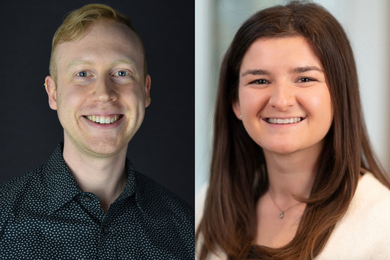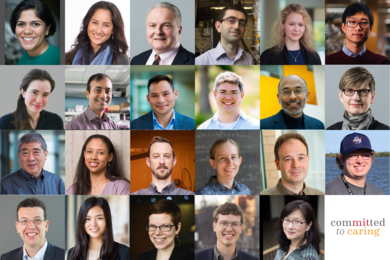Dean for Undergraduate Education and Student Affairs Rosalind H. Williams announced Monday the appointment of Kip V. Hodges, professor of earth, atmospheric and planetary sciences, as dean of undergraduate curriculum in charge of the Undergraduate Affairs Office, effective January 15. He succeeds Professor Travis Merritt, who retired at the end of the September.
"Kip has a deep love of science, an understanding of MIT students, a desire to make MIT education both lively and effective, a sense of humor, articulateness, an ability to work with the staff as well as faculty and students, and common sense combined with a commitment to change," Dean Williams said.
"He has taught geology to undergraduates and graduates including freshman advisor seminars and also field geology, and has done distinguished research in continental tectonics," Dean Williams continued." He has a hands-on active approach to education: doing science in an active and engaged way. In his department, Kip chaired the graduate education committee for four years and served on the graduate admissions committee for five years.
"In the Institute at large, he has chaired the Committee on the Writing Requirement, co-chaired the special subcommittee on writing of the Committee on the Undergraduate Program, and been a leader in bringing these proposals forward to faculty and students.
"In this long and quite complicated process, Kip has shown a remarkable ability to work patiently but persistently in attaining a consensus and in moving forward proposals that involve significant changes but that are also realistic.
"Kip is eager to catalyze educational reforms by working with departments to define what students need and what innovations will help make MIT education as effective and exciting as possible," Dean Williams continued. "We have had numerous conversations on the need for a proactive, collaborative approach in improving MIT education. Kip will be working closely with others in the larger dean's office to help establish a solid administrative framework, a team approach, for our new organization.
"He will continue his research in continental tectonics, serving the Dean's Office half-time. I feel it's important in this time of rapid change not to overstaff but to see how the office develops, and make additions later as necessary."
Dean Williams noted that Professor Hodges has been at MIT almost continuously since he finished his undergraduate degree at the University of North Carolina at Chapel Hill in 1978.
Professor Hodges, commenting on the appointment, said, "I believe that we at MIT should work toward a better synchronization of our undergraduate curriculum, so our students can see how the export of concepts from one field might influence new research directions in another.
"Many of the greatest breakthroughs in science and technology occurred because a few scientists and engineers saw the value of expanding their horizons to include the misty regions between established disciplines.
"I would also like to encourage our faculty to explore new, non-traditional teaching methods. We should be world leaders in the perfection of electronic classrooms, in the development of shared learning protocols in technical fields, and in the use of off-campus or `field' courses to enhance the education of our students.
"I have been, and will continue to be, active in the development of a new communications requirement for our undergraduates that will ensure that they leave MIT prepared to engage in the important debates that will shape the future of our world.
"My goal is the same as that of our faculty as a whole: to prepare our students as best we can to ascend to national and international leadership roles in the next century.
"The demands of my own profession provide an important perspective on the value of holistic education. My research specialty, the evolution of mountain ranges, is an extremely integrative topic, requiring me to obtain and synthesize data from numerous subdisciplines within the earth sciences and beyond. It requires a broad foundation in the basic sciences and (more importantly) understanding how they can be combined and focused on research problems. I spend about as much time in the field, in places like Nepal, Tibet and Greenland, as I do in the laboratory working with mass spectrometers and lasers."
Dr. Hodges, 39, received the PhD in geology from MIT in 1982 and spent a year as an assistant professor at the University of Wyoming. He returned to MIT in 1983 as an assistant professor, was named associate professor in 1987 and was granted tenure in 1990. He was appointed a professor in 1993.
He is associate editor of the Geological Society of America Bulletin, and he serves on the editorial boards of Geology and of Contributions to Mineralogy and Petrology. He served in 1991 as a member of the peer review panel of the Department of Energy's early site-suitability evaluation for the potential high-level nuclear waste repository at Yucca Mountain, NV, and also served the National Science Foundation from 1990 to 1992 as a member of the Tectonics Review Panel.
"This appointment concludes the search for a successor to Travis Merritt, who announced his plans to retire last spring. I discussed the process with administrators, staff and students; everyone agreed that we should be looking for an MIT faculty member," Dean Williams said, adding that she was grateful to all who have participated in the search process.
The internal search had three components, she added. All faculty in August were sent a letter, soliciting self-nominations and nominations of others. She interviewed all those who responded. She discussed the position with about a dozen people on the Undergraduate Academic Affairs Staff, and she also met all the associate deans both individually and as a group.
Students leaders were contacted over the summer by e-mail and invited to comment on the search and after the beginning of the term, four open meetings were held to get student input.
A version of this article appeared in MIT Tech Talk on October 30, 1996.





